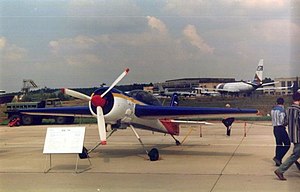
The Yakovlev Yak-42 is a 100/120-seat three-engined mid-range passenger jet developed in the mid 1970s to replace the technically obsolete Tupolev Tu-134. It was the first airliner produced in the Soviet Union to be powered by modern high-bypass turbofan engines.
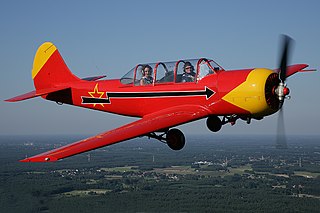
The Yakovlev Yak-52 is a Soviet primary trainer aircraft which first flew in 1976. It was produced in Romania from 1977 to 1998 by Aerostar, as Iak-52, which gained manufacturing rights under agreement within the former COMECON socialist trade organisation. The Yak-52 was designed as an aerobatic trainer for students in the Soviet DOSAAF training organisation, which trained civilian sport pilots and military pilots. Currently the Yak-52 is used in the Fédération Aéronautique Internationale (FAI) World Aerobatic Yak 52 Competition, a popular powered aircraft one-design World Aerobatic Championship.

The Yakovlev UT-2 is a single-engine tandem two-seat low-wing monoplane that was the standard Soviet trainer during World War II. It was used by the Soviet Air Force from 1937 until replaced by the Yakovlev Yak-18 during the 1950s.

The Yakovlev Yak-15 is a first-generation Soviet turbojet fighter developed by the Yakovlev design bureau (OKB) immediately after World War II. The main fuselage was that of Yakovlev Yak-3 piston-engine fighter modified to mount a reverse-engineered German Junkers Jumo 004 engine. The Yak-15 and the Swedish Saab 21R were the only two jets to be successfully converted from piston-power to enter production. 280 aircraft were built in 1947. Although nominally a fighter, it was mainly used to qualify piston-engine-experienced pilots to fly jets.

The Yakovlev Yak-17 is an early Soviet jet fighter. It was developed from the Yak-15, the primary difference being tricycle landing gear. The trainer version, known as the Yak-17UTI, was the only Soviet jet trainer of the 1940s. Both aircraft were exported in small numbers and the Yak-17 was soon replaced by the far superior Mikoyan-Gurevich MiG-15 beginning in 1950.

The Yakovlev Yak-44 was a proposed twin-turboprop Airborne Early Warning (AEW) aircraft, resembling the United States Navy's E-2 Hawkeye, intended for use with the Soviet Navy's Ulyanovsk class supercarriers. Along with the aircraft carrier it would have flown from, the Yak-44 was cancelled after the demise of the Soviet Union. A full-scale mockup with foldable wings was built.

The Yakovlev Yak-18T is a four- or five-seat fully aerobatic utility aircraft developed by Yakovlev. Introduced to train Aeroflot pilots, it has gained some popularity as a sportplane both inside and outside the former USSR. It is powered by a 268-298 kW (360-400 hp) Vedeneyev M14P radial engine, and is designed for stresses of +6.48/-3.24 g.
The Yakovlev Yak-46 was a proposed aircraft design based on the Yak-42 with two contra-rotating propellers on the propfan located at the rear. The specification of the Samara turbofans was in the 11,000 kg thrust range. Though proposed in the 1990s, production of the Yak-46 never commenced.

The Yakovlev Yak-55 is a single-seat aerobatic aircraft. Pilots flying the Yak-55 have won several world aerobatic championships.
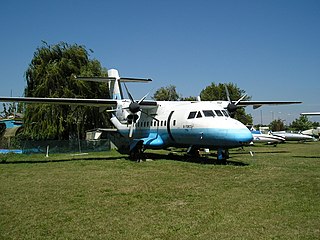
The Let L-610 is a prototype aircraft for the Czech civil aircraft manufacturer Let Kunovice made in 1988–1997.
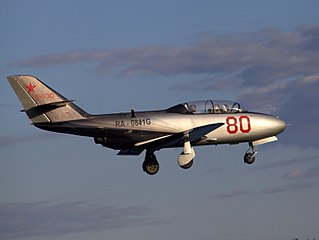
The Yakovlev Yak-30, originally designated Yakovlev 104, was Yakovlev's entry in a competition for the first military jet trainer aircraft designed for Warsaw Pact nations. Designed to succeed the Yak-17UTI, it also led to the development of the Yakovlev Yak-32 sport jet. The Yak-30 lost to the L-29 Delfin, and neither it nor the Yak-32 entered production.

The Yakovlev Yak-50 aerobatic aircraft is a single-seat all-metal low-wing monoplane with retractable main wheels and exposed tail wheel. The control surfaces are fabric-covered to save weight. The aircraft is not equipped with flaps.
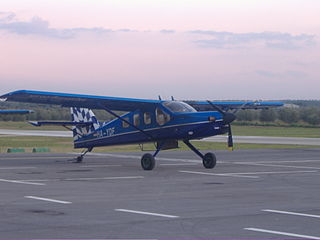
The Technoavia SM92 Finist is STOL utility aircraft, designed by the Russian company Technoavia which first flew on the 28 December 1993. It is built at the Smolensk Aviation Plant.
The Yakovlev Yak-20 was an experimental piston-engined trainer developed in the Soviet Union in 1949. It did not go into production.

The Il-54 was a transonic bomber developed in the USSR in the 1950s. Only two examples were built before the project was abandoned.
The Yakovlev Yak-58 is a small, multi-role utility transport and business aircraft. The aircraft features a pusher engine and twin boom tail. It saw limited production in the late 1990s.

The Yakovlev Yak-32 is a single-seat version of the Yakovlev Yak-30 (1960), and was claimed by the OKB to be the world's first sporting aircraft with an ejection seat. This version was designated Yak-104PS. Neither the Yak-30 nor the Yak-32 entered production.
The Yakovlev Yak-10 was a Soviet light liaison aircraft designed and built by the Yakovlev design bureau in the 1940s.
The Aviatika-900 Acrobat is a 1990s Russian single-seat aerobatic monoplane designed and built by Aviatika Joint Stock Company. The aircraft is sometimes referred to as the MAI-900 Acrobat, the Moscow Aviation Institute being one of the constitute organisations when the company was formed in 1993.

The Yakovlev Yak-152 is a Russian primary trainer aircraft from the Yakovlev Design Bureau, part of the Irkut Corporation. The prototype Yak-152 first flew on 29 September 2016, powered by a RED A03 diesel engine, rated at 500 shp (370 kW). The aircraft has been ordered by the Russian Aerospace Forces to replace aging Yakovlev Yak-52 trainers. Currently being manufactured in Irkutsk.
